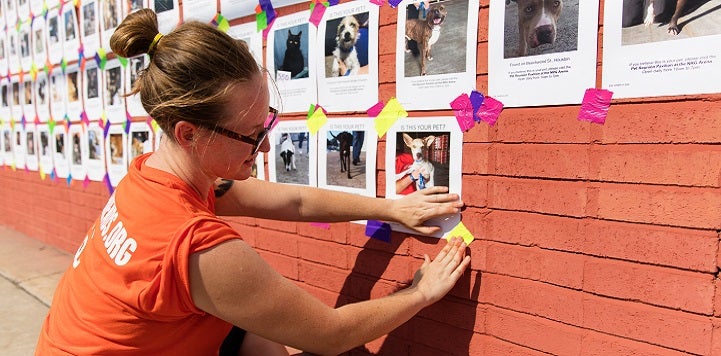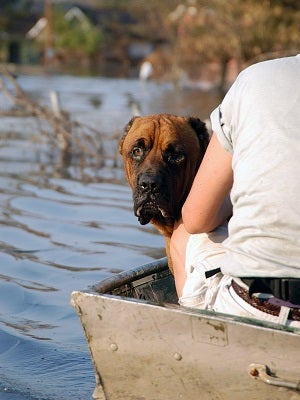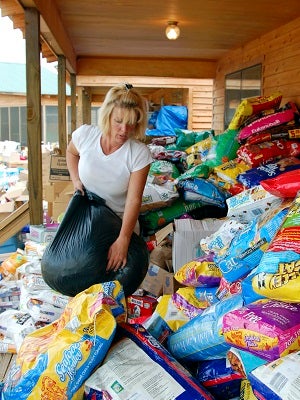
“Ready or Not, here it Comes"
June 7, 2023
Emergency preparedness planning: Is your agency ready?
Many of you, if not all, have likely experienced an emergency of some sort (or 10) in the past decade. For those of you who have hurricanes on your disaster Bingo card, you are well aware that the 2023 Atlantic hurricane season recently kicked off on June 1 and continues through November 30. But were you also aware that it is officially National Pet Preparedness Month? Since natural or human-caused disasters don’t abide by a calendar or pay attention to geographic boundaries, animal shelters and rescue organizations must have preparedness plans ready to roll in case a situation arises requiring evacuation or sheltering in place for days at a time. It’s a good idea to encourage community members to do the same for their families (which is also likely to make your organizations’ life easier).
 Unfortunately, preparing for emergencies isn’t always a guarantee. In the 20-plus years that I've been doing disaster management, I’ve noticed that many shelters are sorely lacking some structure around how they would respond to an emergency. A lot of shelter responses I’ve seen appear incredibly reactive instead of formalized and coordinated. That even applies to some shelters whose municipal contracts require them to support the community’s pets in times of disaster. It's really important to be prepared, and to consider secondary hazards, too. Whoever imagined that a record-breaking deep freeze in Texas would take second stage to subsequent power outages and bursting water pipes that immediately followed?
Unfortunately, preparing for emergencies isn’t always a guarantee. In the 20-plus years that I've been doing disaster management, I’ve noticed that many shelters are sorely lacking some structure around how they would respond to an emergency. A lot of shelter responses I’ve seen appear incredibly reactive instead of formalized and coordinated. That even applies to some shelters whose municipal contracts require them to support the community’s pets in times of disaster. It's really important to be prepared, and to consider secondary hazards, too. Whoever imagined that a record-breaking deep freeze in Texas would take second stage to subsequent power outages and bursting water pipes that immediately followed?
With the increase of disasters in both intensity and frequency, emergency planning has never been more important. In fact, the Association of Shelter Veterinarians (ASV) just updated their Guidelines for Standards of Care in Animal Shelters, which includes an entire section dedicated to the absolute need for written disaster plans. It refers to the importance of outlining “the actions the shelter will take in response to likely emergency scenarios.” But since people don't know what they don't know, it can be tough to even know where to start. That’s a big reason why Best Friends has created a range of resources to help organizations with this task (see end of program spotlight for a full list), including our brand-new Emergency Preparedness Toolkit. No matter what the situation, we want to make planning to keep people and animals safe as easy as possible. (Check out the section on Emergency Tip Sheets while you’re there.)
What’s in the toolkit?
The toolkit gives agencies a step-by-step guide to building out your organization’s unique plans, starting with a hazard analysis with a numbered scale to rate the frequency and likelihood of occurrence for each hazard. For higher scores, it includes a section to rate potential impact on staff, volunteers, animals, facility/property, business operations, and community. There are also numerous planning templates that can be utilized based on the risks you are most likely to face, as well as a list of free online training modules. Furthermore, the toolkit contains exercise development resources so organizations can conduct drills for staff and volunteers—especially foster parents. Developing a plan, training staff, and conducting exercises using likely scenarios helps you figure out which elements of your plans work, and which need to be adjusted. The toolkit was designed as a plug-and-play template that can be tailored to each agency, but we can provide coaching on plan development if shelters need help.
There are also resources to help shelters recruit external partners for critical support like veterinary care. And in some cases, your agency might be the one assisting another organization. For instance, Jacksonville Humane Society (JHS) regularly transports animals out of its facility to other regions of the country to make room for those from Florida shelters directly impacted by storms (when JHS isn’t facing its own storm, that is).
What’s next?
 A second part of the toolkit is in the works focusing on how shelters can prepare to effectively support their community during disasters and further addressing shelter partnerships like the ones JHS has with other organizations in the state. It’s all about how shelters support one another, even creating mutual aid agreements. The forthcoming resource will also address other community relationships, including how to build relationships with your local emergency management agency, as well as how to educate the public about preparedness planning and how to lean on them when we need their support.
A second part of the toolkit is in the works focusing on how shelters can prepare to effectively support their community during disasters and further addressing shelter partnerships like the ones JHS has with other organizations in the state. It’s all about how shelters support one another, even creating mutual aid agreements. The forthcoming resource will also address other community relationships, including how to build relationships with your local emergency management agency, as well as how to educate the public about preparedness planning and how to lean on them when we need their support.
The second part will also feature a section on how to manage disaster requests for donations (though we currently have an online module, “Disaster Donations: Money & Material Items,” on the network website). You really don’t want the headache of cleaning, sorting, and storing the hundreds of unsolicited items you never requested that end up showing up. That's definitely not what donors intended when they donated items to your shelter. Communicating quickly and effectively with the public (i.e. - your potential donors) about what you truly need is critical.
Is this toolkit really for your organization?
Even if your shelter thinks “We have done this so many times before, so we know how to do this,” or “This is the way we always respond,” the toolkit is for you, too. Just because you have managed to avoid the negative consequences of a disaster several times before doesn't necessarily mean it's the most effective way to respond to an emergency. Sometimes shelters haven’t thought about the order in which animals should be evacuated, or even considered what’s involved in moving animals to another location. Perhaps you never had to do that before. In addition, if it isn’t documented and you deal with continual staff turnover, having a comprehensive, documented plan is the best way to orient new incoming staff.
There also can be a complacency that comes along with experiencing repetitive disasters yet never being directly impacted. Especially with climate change, any shelter across the country at this point may eventually find themselves under some type of threat. Whether your facility is located near mountains, a lake, or the ocean . . . it doesn't matter. What once happened in a neighboring state can and likely will impact you at some point, too.
Organizations handling lots of animals should always be prepared, especially because we are not yet at the point where we can rely on local or federal emergency management agencies to include pets in their response planning. There has been some progress on incorporating animals in plans, especially after the lessons learned post-Hurricane Katrina and due to the creation of the Pets Evacuation and Transportation Standards Act of 2006 (PETS Act), but there's so much more that needs to happen.
There are synergies and partnerships yet to be created in a lot of communities, and we want to help create those. How will we do that? Well, we just did a presentation to the Federal Emergency Management Agency addressing how and why the lack of pet reunification preparedness planning on the government side has such a negative impact on shelters and shelter animals, where it can sometimes lead to high euthanasia rates. We believe that educating the emergency management community on how sometimes their lack of planning efforts can have a direct impact shelter animals may turn into an “A-ha” moment. And hopefully, that leads to additional lifesaving changes that work hard to keep families intact even when the worst happens.
For more information about planning for an emergency, check out the following resources:
Training modules
- “Disaster Preparedness”
- “ABC’s of Animal Behavior in Cats & Canines”
- “Emergency Shelter Intake Process”
- “Cleaning Protocols”
- “Canine Handling”
- “Emergency Animal Transport Coordination”
- “Emergency Shelter Disease Prevention & Outbreak Mitigation”
- “Disaster Donations: Money & Material Items”
Training modules for fosters
Training modules for the public
Preparedness resources for the public
- “Preparing Yourself and Your Pets for Emergencies”
- “How to Help Your Pets in an Emergency or Natural Disaster”
- “Natural Disaster Preparedness for Families with Pets”
- “Pet Natural Disaster Checklist and Emergency Plan”
- “How You Can Help Shelter Pets in an Emergency or Natural Disaster”
Podcasts
Other Best Friends Network resources
Sharon Hawa
Senior manager of emergency services
Best Friends Animal Society
If you enjoyed this program spotlight, you can find our complete catalog of spotlights here.